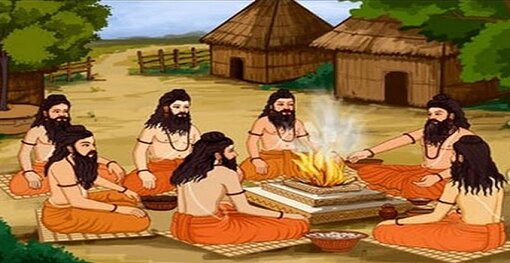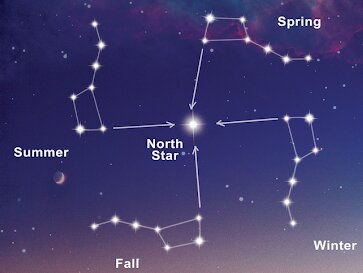
Saptarishi (meaning seven sages) is a group of seven sages in Hinduism who direct humanity after Pralaya and build the foundation of dharma. Per some beliefs, they are mind-born sons of Lord Brahma and live for a Manvantara (306,720,000 Earth Years). At the end of a Manvantara, they merge into Lord Brahma, and new Saptarishi are created in the next Manvantara. Some texts, like Gopatha Brahmand and Brahmanda Purana, mention the names of eight sages as Saptarshi.
What are the Saptarishi:
Saptarishi are a group of Vedic sages who built the foundation of Hinduism. They created many hymns and mantras in the Vedas. They were great ascetics and did penance for many years and achieved divine powers. Some of them are Brahmarishis. A Brahmarshi is a sage who has attained enlightenment by completely understanding the meaning of Brahman and has attained the highest divine knowledge. So they rank higher than the other sages.
It is believed that Lord Shiva is their teacher. During the onset of every Satya Yuga, Saptarishis come to Earth and recount dharma that is lost by the end of Kali Yuga. It is believed that they are so powerful that they can defeat any weapon on the Earth.
The names of Saptarshi for the current Manvantara are Atri, Bharadvaja, Gautama, Jamadagni, Kashyapa, Vashishta, and Vishvamitra.
1. Atri:
Sage Atri is the father of Lord Dattatreya, who is one of the most popular Hindu gods. The fifth Mandala (Book 5) of Rigveda is called the Atri Mandala in his honor, and the eighty-seven hymns in it are attributed to him and his descendants. Sati Anusaya, who is one of the most chaste women in Indian history, was his wife.
2. Bharadvaja:
Bharadvaja is a revered Vedic sage (maharishi) from Ancient India. He is the son of Devaguru Brihaspati. He is a renowned scholar, economist, grammarian, and physician. His contributions to ancient Indian literature, specifically the Rig Veda, provide significant insight into ancient Indian society. He and his family of students are the authors of the sixth book of the Rigveda. In the epic Mahabharata, Bharadwaja is the father of the Droṇacharya, the instructor to Pandavas and Kaurava princes. Bharadwaja is also mentioned in Charaka Samhita, an authoritative ancient Indian medical text.
During their exile, Lord Rama and others rested in Bharadwaja’s ashrama when they were crossing Prayag and accepted his offerings.
3. Gautama:
Sage Gautama is a Maharishi. He is the son of Maharshi Dirghatamas or Rahugana and Mata Pradveshi. He is the husband of Ahalya. Sage Gautama is credited with the creation of the river Godavari, which is also known as Gautami. Sage Gautama wrote Gautama Dharmasutra, which is the first scripture in social and religious laws. He also wrote Gautama Medhsutra.
4. Jamadagni:
Sage Jamadagni was the father of Lord Parashurama, who is one of the incarnations of Lord Vishnu. He was the descendants of Sage Bhrighu, who had dared to kick Lord Vishnu. Like his ancestor, he was also known for his angry nature.
Once his wife, Renuka, was late to bring water for a ritual. With his divine powers, he understood that she was watching Gandharvas and Apsaras sporting in the water, and the thoughts of luxurious life rose in her mind. Therefore, he ordered his son to kill her. Upon the request of his son, he brought her back to life.
He had a divine cow named Kamadhenu at his hermitage, which King Sahastrarjuna wanted to take away by force. But Sage Jamadagni opposed him. Therefore, while he was meditating, Sahastrarjuna killed him. After knowing about this incident, Lord Parashurama became angry and killed 21 generations of Kshatriya over time.
5. Kashyapa:
Sage Kashyapa is the father of gods and Asuras. Kashyapa is credited with composing a few hymns in the Rigveda, mainly in Mandala IX. He and his family of students are mainly composers of hymns for Soma Pavamāna (“self-purifying Soma”), which represents a single moment in the Soma sacrifice. Per some scholars, the name Kashmir could have been a shortened form of “Kashyapa Mira”, or the “lake of the sage Kashyapa”. Alternatively, it may come from a Kashmiri or Sanskrit term that means “to dry up water”. It could also have been derived from the term “Kashyapa Meru”, which means the sacred mountains of Kashyapa.
6. Vashishtha:
Sage Vashishtha was the guru of Lord Rama. He is a mind-born son of Lord Brahma. He is credited as the chief author of Mandala 7 of the Rigveda. The Yoga Vasishtha, Vasishtha Samhita, as well as some versions of the Agni Purana and Vishnu Purana are attributed to him.
He is the husband of Arundahit and therefore is called Arundhati Natha. He suffered a lot because of his feud with Sage Vishwamitra.
7. Vishwamitra:
Sage Vishwamitra was born as a Kshatriya but later became a Brahmin and one of the greatest sages of ancient India. He is so powerful that he was about to create Pratisrushti (a replica of the world). He is credited with the creation of the Gayatri Mantra, which is one of the most popular Hindu mantras.
Sage Vishwamitra is also credited as the author of most of Mandala 3 of the Rigveda, Due to some reasons, he became an enemy of Sage Vashishtha. His real name was Kaushika. He also tested the honesty of King Harishachandra by making him undergo severe mental and physical tortures.
Feared by his severe penance, Indra sent an Apsara named Menaka to disturb him. She succeeded in doing so. Their union resulted in the birth of Shakuntala, the mother of King Bharata, from whose name India got its name Bharata.
The Birth of Saptarishi:
There are different stories about the birth of Saptarishis. According to some texts, Saptarshi are born from the mind of Lord Brahma. Per the Brahmanda Purana, they were born from a yajna by Lord Brahma, while some texts mention that some of them were born naturally. E.g., Jamadagni was the son of Richika and Satyavati.
Wives of Saptarishi:
Marichi – Kala
Bharadwaja – Susheela.
Atri – Anasuya
Angiras – Sraddha
Pulastya – Havirbhu
Pulaha – Gati
Kratu – Kriya
Bhrigu – Khyati
Vashishtha – Arundhati
Jamadagni – Renuka.
Vishwamitra – Kumudhwati.
Gautama – Ahalya.
Kashyapa – Diti, Aditi
Children of Saptarshi:
Kashyapa – Most of the gods and Asuras.
Atri – Dattatreya, Soma, Durvasa.
Bharadwaja – Dronacharya.
Gautama – Vamadeva, Nodha.
Jamadagni – Parashurama.
Vashishtha – Shakti.
What is the Saptarishi Mandala:

Mandala is a Sanskrit word, which means a circle. Saptarishi Mandala is a circle formed by the revolution of the group of seven stars (Saptarishi) in the Big Dipper constellation around the Pole star. The names of these seven stars are Vashishtha, Marichi, Pulastya, Pulaha, Atri, Angiras, and Kratu. There is another star faintly visible within it called Arundhati. Arundhati is the wife of Sage Vashishtha per Hindu scriptures.
The Pole star is fixed and never changes its position. As shown in the above picture, when Saptarshi completes one revolution around the pole star, the figure looks like a Swastika, which is an ancient Hindu symbol that means “auspicious”. The Vedas postulate that ‘Swastika’ represents it as the Universe in our spiral galaxy in the forefinger of the creator. The swastika is a geometric pattern in the sky representing the north ecliptic pole.
Names of Saptarishi:
Different names of Saptarishi appear in different Hindu scriptures because, in every Manvantara, new Saptarishi are created. The oldest list of Saptarishi names is found in Jaiminiya Brahmana.
A. Jaiminiya Brahmana (2.218-221): Agastya, Atri, Bharadwaja, Gautama, Jamadagni, Vashishtha, and Vishwamitra.
B. Shatapatha Brahmana and Brihadnayaka Upanishada 2.2.6: Atri, Bharadwaja, Gautama, Jamadagni, Kashyapa, Vashishtha, and Vishwamitra.
C. Gopatha Brahmana 1.2.8: This text mentions the names of eight Rishis, viz. Agastya, Bharadwaja, Gautama, Gungu, Jamadagni, Kashyapa, Vashishtha, and Vishwamitra.
D: Krishna-Yajurveda in the Sandhya-Vandana Mantras: Angiras, Atri, Bhrigu, Gautama, Kashyapa, Kutsa, and Vashishtha.
E. Mahabharata: Marichi, Atri, Pulaha, Pulatsya, Kratu, Vashishtha, and Kashyapa.
F. Brihat Samhita: Marichi, Vashishtha, Angiras, Abhi, Pulastya, Pulaha, and Kratu.
G. Shrimad Bhagavatam: Kaśyapa, Atri, Vashishṭha, Vishvamitra, Gautama, Jamadagni, and Bharadvāja.
H. Bramhanda Purana: Bhrigu, Angiras, Marichi, Pulastya, Pulaha, Kratu, Atri, and Vashishtha.
Names of Saptarishi in each Manvantara of Present Kalpa:
Svayambhuva: Atri, Angiras, Pulaha, Pulatsya, Kratu, Marichi, and Vashishtha.
Svarocisha: Urja, Stambha, Prana, Vata, Prishava, Niraya, and Parivan.
Uttama: Kaukundihi, Kurundi, Dalaya, Sankha, Pravahita, Mita, and Sammita.
Tapasa/Tamasa: Jyotirdhama, Prithu, Kavya, Chaitra, Agni, Vanaka, and Pivara.
Raivata: Hirannyaroma, Vedasrí, Urdhabahu, Vedabahu, Sudhama, Parjanya and Mahamuni.
Chakshusha: Sumedha, Viraja, Havishman, Uttar, Madhu, Sahishnu, and Atinama.
Vaivasvata (current): Vashishta, Kashyapa, Atri, Jamadagni, Gautama, Vishvamitra, Bharadvaja.
Savarni: Diptimat, Galava, Rama, Kripa, Drauni or Ashwatthama, Vyasa, and Rishyasringa.
Daksha-savarni: Savana, Dyutimat, Bhavya, Vasu, Medhatithi, Jyotishman, and Satya.
Names of Saptarishi in the next Manvantara:
Diptima, Galava, Parashurama, Kripa, Drauni or Ashwatthama, Vyasa, and Rishyasringa.
Rishi Panchami:
Because of their contribution to the welfare of humanity, Saptarshi are highly revered and worshiped by Hindus. On Shukla Paksha Panchami in the Hindu month of Bhadrapada, Rishi Panchami is celebrated. This festival falls on the next day of Ganesh Chaturthi. On this day, Saptarishi are worshipped. People observe fast on this day.
Saptarishi Temples:
There are many temples of Saptarishi across India. Some temples are dedicated to individual sages, like Vashishtha, Agastya, etc.
Stories of Saptarishi:
Nahusha and Saptarishi:
After becoming the king of heaven, Nahusha becomes arrogant and starts drinking heavily. On top of that, he develops a lust for Indrani, who is Indra’s wife, and orders her to sleep with him. But Indrani puts a condition before him that she would fulfill his wish only if he comes in a palanquin carried by Saptarishi.
Nahusha readily agrees and orders Saptarishi to carry his palanquin to Indrani’s palace. The sages being old carry the palanquin slowly, but due to being drunk and eager to reach the palace, Nahusha scolds them for being slow and calls them snakes. Because of the tiredness, one of the sages falters, and Saptarshi stops the palanquin. Angry Nahusha kicks the Rishi, who is Sage Agastya. The infuriated sage curses him to be a snake.
Manu and Saptarishi:
When the great deluge happened, Lord Vishnu took the form of a fish and steered Manu’s boat to a safe place. This boat contained pairs of all animals and seeds of all plants on earth. It also carried Saptarishi who then helped Manu restore dharma after the deluge was over.
Are Saptarishi Immortal:
It is believed that Saptarishi are semi-immortal and have a very long lifespan. Generally, they live for a Manvantara (306,720,000 Earth years). At the end of a Manvantara, they merge into Lord Brahma, and new Saptarishi are created in the next Manvantara.
But it seems they are not immortal because Sage Jamadagni was killed by Sahastrarjuna. Therefore, it is possible to kill a Saptarshi, but the consequences are severe. Parashurama destroyed 21 generations of Kshatriya for killing a Saptarishi.
Where are Saptarishi now?
There are different opinions about this. Some people say they reside on the seven stars of Saptarshi Mandala. Per Shrimad Bhagavatam, they are residing in their ashramas currently.
“O King, during the eighth manvantara, the great personalities Gālava, Dīptimān, Paraśurāma, Aśvatthāmā, Kṛpācārya, Ṛṣyaśṛṅga, and our father, Vyāsadeva, the incarnation of Nārāyaṇa, will be the seven sages. For the present, they are all residing in their respective āśramas.”
– 8.13-15 and 8.13.16
Most likely, they are living on the Earth in subtle bodies.